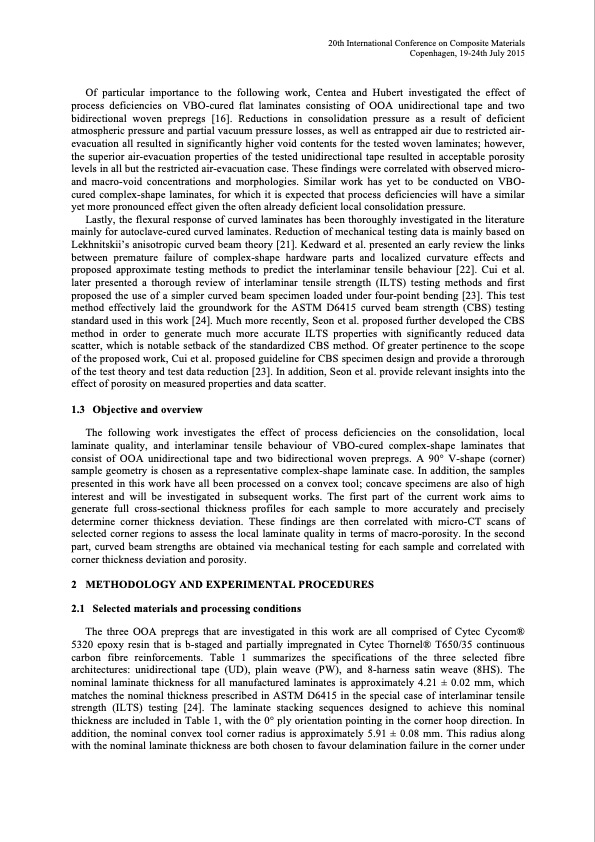
PDF Publication Title:
Text from PDF Page: 003
20th International Conference on Composite Materials Copenhagen, 19-24th July 2015 Of particular importance to the following work, Centea and Hubert investigated the effect of process deficiencies on VBO-cured flat laminates consisting of OOA unidirectional tape and two bidirectional woven prepregs [16]. Reductions in consolidation pressure as a result of deficient atmospheric pressure and partial vacuum pressure losses, as well as entrapped air due to restricted air- evacuation all resulted in significantly higher void contents for the tested woven laminates; however, the superior air-evacuation properties of the tested unidirectional tape resulted in acceptable porosity levels in all but the restricted air-evacuation case. These findings were correlated with observed micro- and macro-void concentrations and morphologies. Similar work has yet to be conducted on VBO- cured complex-shape laminates, for which it is expected that process deficiencies will have a similar yet more pronounced effect given the often already deficient local consolidation pressure. Lastly, the flexural response of curved laminates has been thoroughly investigated in the literature mainly for autoclave-cured curved laminates. Reduction of mechanical testing data is mainly based on Lekhnitskii’s anisotropic curved beam theory [21]. Kedward et al. presented an early review the links between premature failure of complex-shape hardware parts and localized curvature effects and proposed approximate testing methods to predict the interlaminar tensile behaviour [22]. Cui et al. later presented a thorough review of interlaminar tensile strength (ILTS) testing methods and first proposed the use of a simpler curved beam specimen loaded under four-point bending [23]. This test method effectively laid the groundwork for the ASTM D6415 curved beam strength (CBS) testing standard used in this work [24]. Much more recently, Seon et al. proposed further developed the CBS method in order to generate much more accurate ILTS properties with significantly reduced data scatter, which is notable setback of the standardized CBS method. Of greater pertinence to the scope of the proposed work, Cui et al. proposed guideline for CBS specimen design and provide a throrough of the test theory and test data reduction [23]. In addition, Seon et al. provide relevant insights into the effect of porosity on measured properties and data scatter. 1.3 Objective and overview The following work investigates the effect of process deficiencies on the consolidation, local laminate quality, and interlaminar tensile behaviour of VBO-cured complex-shape laminates that consist of OOA unidirectional tape and two bidirectional woven prepregs. A 90° V-shape (corner) sample geometry is chosen as a representative complex-shape laminate case. In addition, the samples presented in this work have all been processed on a convex tool; concave specimens are also of high interest and will be investigated in subsequent works. The first part of the current work aims to generate full cross-sectional thickness profiles for each sample to more accurately and precisely determine corner thickness deviation. These findings are then correlated with micro-CT scans of selected corner regions to assess the local laminate quality in terms of macro-porosity. In the second part, curved beam strengths are obtained via mechanical testing for each sample and correlated with corner thickness deviation and porosity. 2 METHODOLOGY AND EXPERIMENTAL PROCEDURES 2.1 Selected materials and processing conditions The three OOA prepregs that are investigated in this work are all comprised of Cytec Cycom® 5320 epoxy resin that is b-staged and partially impregnated in Cytec Thornel® T650/35 continuous carbon fibre reinforcements. Table 1 summarizes the specifications of the three selected fibre architectures: unidirectional tape (UD), plain weave (PW), and 8-harness satin weave (8HS). The nominal laminate thickness for all manufactured laminates is approximately 4.21 ± 0.02 mm, which matches the nominal thickness prescribed in ASTM D6415 in the special case of interlaminar tensile strength (ILTS) testing [24]. The laminate stacking sequences designed to achieve this nominal thickness are included in Table 1, with the 0° ply orientation pointing in the corner hoop direction. In addition, the nominal convex tool corner radius is approximately 5.91 ± 0.08 mm. This radius along with the nominal laminate thickness are both chosen to favour delamination failure in the corner underPDF Image | VACUUM-BAG-ONLY COMPLEX-SHAPE PREPREG LAMINATE

PDF Search Title:
VACUUM-BAG-ONLY COMPLEX-SHAPE PREPREG LAMINATEOriginal File Name Searched:
paper-2206.pdfDIY PDF Search: Google It | Yahoo | Bing
5,000 BF Shipping Container Lumber Dry Kiln For Quality Lumber The 5,000 BF container kiln consists of one 40 foot high-cube aluminum shipping container... More Info
Shipping Container Lumber Dry Kilns by Global Energy Global Energy designed and developed the container kiln back in 1991. The purpose is to give access to portable sawmill owners, furniture makers, and small business the value added profit of dry kiln lumber and quality hardwoods... More Info
Vacuum Kiln Conversion Kit for Lumber and Wood Dry Kilns Convert your existing conventional dry kiln into a fast drying vacuum kiln. Similar to vacuum bagging in the boat building and aircraft industry, we have come up with a proprietary process which allows you to build a very simple vacuum kiln at a fraction of the price, and without the intensive conventional metal chamber structure... More Info
Vacuum Pump Cart System for Bagging Clamping Wood Drying and more Vacuum Cart with 2HP Pump and Dual Pistons with multiple multiplex vacuum ports and liquid reservoir... More Info
Vacuum Bagging Basics Vacuum bagging is a method of clamping, which has traditionally been used in the composites industry, but can also be used for vacuum drying materials, including wood products... More Info
| CONTACT TEL: 608-238-6001 Email: greg@globalmicroturbine.com | RSS | AMP |